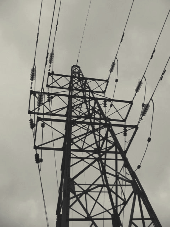Sudan electricity sector is plagued by poor infrastructure
July 16, 2004 (LiquidAfrica) — Sudan’s electricity sector is plagued by poor infrastructure, frequent outages and a small customer base, problems that the Ministry of Energy and the state-owned National Electricity Corporation (NEC) have only begun to address in the last five years.
 Currently, Sudan has 728 megawatts (MW) of electric generation capacity, which includes roughly equal amounts of thermal (mainly oil) and hydropower capacity.
Currently, Sudan has 728 megawatts (MW) of electric generation capacity, which includes roughly equal amounts of thermal (mainly oil) and hydropower capacity.
The country’s main generating facility is the 280-MW Roseires dam located on the Blue Nile river basin, approximately 315 miles southeast of Khartoum.
The insufficiency of the country’s generation fleet can be attributed mainly to a lack of expansion in the face of rising electricity demand, but has also been exacerbated by the reliance on hydropower generation, which varies depending on rainfall.
In 2002, Sudan’s total electricity generation was 2.4 billion kilowatthours (kwh). Electricity is transmitted by way of two interconnected electrical grids the Blue Nile Grid and the Westen grid although together, they cover a small portion of the country.
Regions not covered by the grid rely on small-scale diesel fired generators. In total, it is estimated that only 30% of Sudan’s population has access to electricity, but the country has set a goal of increasing that to 90%, at a cost of $3 billion, in coming years.
Underinvestment in the electricity sector due to a lack of funding is largely blamed for its deterioration during the 1990’s. In 2000, the NEC launched the Rehabilitation and Performance Improvement Program, aimed at upgrading the existing electricity infrastructure in order to improve the adequacy and reliability of the electricity supply.
This program is supported by a $10 million loan from OPEC’s Fund for International Development. In response Sudan’s power shortage problems, projects are underway to add both fossil-fueled and hydropower generating capacity.
The largest of these projects are the proposed Merowe and Kajbar hydroelectric facilities in northern Sudan. The 1,250-MW Merowe facility is to be located 250 miles north of Khartoum at the Nile River’s fourth cataract. So far, Egypt has voiced no major objections to the project’s planned diversion of Nile River flows.
Construction is to begin this year, with completion scheduled for July 2008. In December 2003, the French power firm, Alstom agreed to a $300 million contract to construct the dam, while Harbin Power of China signed an agreement to build seven substations and around 1,000 miles of transmission lines.
In 2002, the Merowe project received major funding commitments from Saudi Arabia, Qatar, and other Arab investors, each of whom pledged loans of $15 million or more.
Two consortia met the October 2002 deadline to bid for the contract to build three packages of the civil works portion of the dam, which is estimated to cost $1.9 billion.
The consortia are a joint venture of China International Water & Electric and China National Water Resources & Hydropower Engineering Corporation, and a joint venture of Consolidated Contractors International Company (CCC) of Greece and Salini Costruttori of Italy.
The Kajbar Dam, located at the Nile’s second cataract, is currently under construction, and will have a 300-MW capacity. An agreement to finance the Kajbar project was signed between Sudan and China in September 1997.
Under terms of the agreement, China is financing 75% of the project (approximately $200 million) and Sudan is to provide the remaining 25%. Environmental groups have expressed concern about Kajbar Dam, citing potential damage both to the Nile ecosystem and to the culture of the displaced Nubian residents of the area.
The director of the NEC said in April 2001 that Sudan and Ethiopia had agreed to link their power grids. A related report in April 2001 indicated that Ethiopia had agreed to export power to Sudan (and Djibouti).
In September 2002, Ethiopian television reported that the two nations had agreed to do what was necessary to implement previously proposed development projects through joint use of Nile waters, though the report did not give details about what was expected from each nation.
